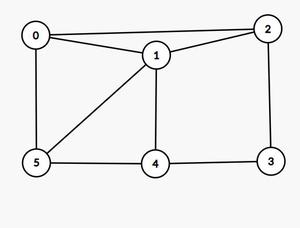给定一个由大小为N*N的邻接矩阵graph[][]形式的N 个节点组成的无向图,任务是在给定的无向图中打印所有可能的哈密顿循环(以起始顶点为“0”)。
A Hamiltonian cycle (or Hamiltonian circuit) is a Hamiltonian Path such that there is an edge (in the graph) from the last vertex to the first vertex of the Hamiltonian Path.
例子:
Input: graph[][] = {{0, 1, 1, 0, 0, 1}, {1, 0, 1, 0, 1, 1}, {1, 1, 0, 1, 0, 0}, {0, 0, 1, 0, 1, 0}, {0, 1, 0, 1, 0, 1}, {1, 1, 0, 0, 1, 0}}
Output:
0 1 2 3 4 5 0
0 1 5 4 3 2 0
0 2 3 4 1 5 0
0 2 3 4 5 1 0
0 5 1 4 3 2 0
0 5 4 3 2 1 0
Explanation:
All Possible Hamiltonian Cycles for the following graph (with the starting vertex as 0) are

- {0 → 1 → 2 → 3 → 4 → 5 → 0}
- {0 → 1 → 5 → 4 → 3 → 2 → 0}
- {0 → 2 → 3 → 4 → 1 → 5 → 0}
- {0 → 2 → 3 → 4 → 5 → 1 → 0}
- {0 → 5 → 1 → 4 → 3 → 2 → 0}
- {0 → 5 → 4 → 3 → 2 → 1 → 0}
Input: graph[][] = {{0, 1, 0, 1, 1, 0, 0}, {1, 0, 1, 0, 0, 0, 0}, {0, 1, 0, 1, 0, 0, 1}, {1, 0, 1, 0, 0, 1, 0}, {1, 0, 0, 0, 0, 1, 0}, {0, 0, 0, 1, 1, 0, 1}, {0, 0, 1, 0, 0, 1, 0}}
Output: No Hamiltonian Cycle possible
Explanation:
For the given graph, no Hamiltonian Cycle is possible:

方法:给定的问题可以通过使用回溯生成所有可能的哈密顿循环来解决。请按照以下步骤解决问题:
- 创建一个辅助数组,比如path[]来存储节点的遍历顺序,以及一个布尔数组visited[]来跟踪当前路径中包含的顶点。
- 最初,将源顶点(在本例中为“0”)添加到path 。
- 现在,递归地将顶点一一添加到路径中以找到循环。
- 在将顶点添加到path之前,请检查正在考虑的顶点是否与先前添加的顶点相邻并且不在path 中。如果找到这样的顶点,则将其添加到路径中,并在visited[]数组中将其值标记为true 。
- 如果路径的长度等于N ,并且从路径中的最后一个顶点到0有一条边,则打印路径数组。
- 完成上述步骤后,如果不存在这样的路径,则打印No Hamiltonian Cycle possible 。
下面是上述方法的实现:
Java
// Java program for the above approach
import java.util.ArrayList;
class GFG {
// Function to check if a vertex v
// can be added at index pos in
// the Hamiltonian Cycle
boolean isSafe(int v, int graph[][],
ArrayList path,
int pos)
{
// If the vertex is adjacent to
// the vertex of the previously
// added vertex
if (graph[path.get(pos - 1)][v]
== 0)
return false;
// If the vertex has already
// been included in the path
for (int i = 0; i < pos; i++)
if (path.get(i) == v)
return false;
// Both the above conditions are
// not true, return true
return true;
}
// To check if there exists
// at least 1 hamiltonian cycle
boolean hasCycle;
// Function to find all possible
// hamiltonian cycles
void hamCycle(int graph[][])
{
// Initially value of boolean
// flag is false
hasCycle = false;
// Store the resultant path
ArrayList path
= new ArrayList<>();
path.add(0);
// Keeps the track of the
// visited vertices
boolean[] visited
= new boolean[graph.length];
for (int i = 0;
i < visited.length; i++)
visited[i] = false;
visited[0] = true;
// Function call to find all
// hamiltonian cycles
FindHamCycle(graph, 1, path,
visited);
if (!hasCycle) {
// If no Hamiltonian Cycle
// is possible for the
// given graph
System.out.println(
"No Hamiltonian Cycle"
+ "possible ");
return;
}
}
// Recursive function to find all
// hamiltonian cycles
void FindHamCycle(int graph[][], int pos,
ArrayList path,
boolean[] visited)
{
// If all vertices are included
// in Hamiltonian Cycle
if (pos == graph.length) {
// If there is an edge
// from the last vertex to
// the source vertex
if (graph[path.get(path.size() - 1)]
[path.get(0)]
!= 0) {
// Include source vertex
// into the path and
// print the path
path.add(0);
for (int i = 0;
i < path.size(); i++) {
System.out.print(
path.get(i) + " ");
}
System.out.println();
// Remove the source
// vertex added
path.remove(path.size() - 1);
// Update the hasCycle
// as true
hasCycle = true;
}
return;
}
// Try different vertices
// as the next vertex
for (int v = 0;
v < graph.length; v++) {
// Check if this vertex can
// be added to Cycle
if (isSafe(v, graph, path, pos)
&& !visited[v]) {
path.add(v);
visited[v] = true;
// Recur to construct
// rest of the path
FindHamCycle(
graph, pos + 1,
path, visited);
// Remove current vertex
// from path and process
// other vertices
visited[v] = false;
path.remove(
path.size() - 1);
}
}
}
// Driver Code
public static void main(String args[])
{
GFG hamiltonian = new GFG();
/* Input Graph:
(0) - - -- (2)
| \ / |
| (1) |
| / | |
| / | |
(5)----(4)--(3)*/
int[][] graph = {
{ 0, 1, 1, 0, 0, 1 },
{ 1, 0, 1, 0, 1, 1 },
{ 1, 1, 0, 1, 0, 0 },
{ 0, 0, 1, 0, 1, 0 },
{ 0, 1, 0, 1, 0, 1 },
{ 1, 1, 0, 0, 1, 0 },
};
hamiltonian.hamCycle(graph);
}
} 0 1 2 3 4 5 0
0 1 5 4 3 2 0
0 2 3 4 1 5 0
0 2 3 4 5 1 0
0 5 1 4 3 2 0
0 5 4 3 2 1 0
时间复杂度: O(N!)
辅助空间: O(N)
如果您希望与专家一起参加现场课程,请参阅DSA 现场工作专业课程和学生竞争性编程现场课程。